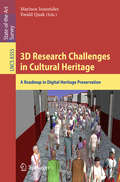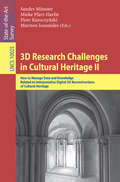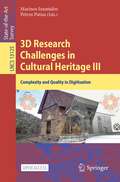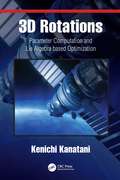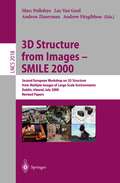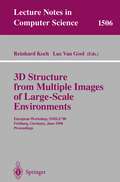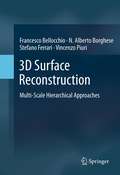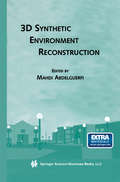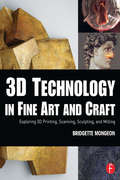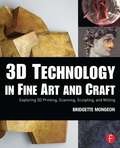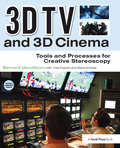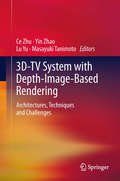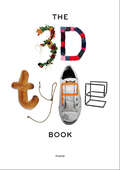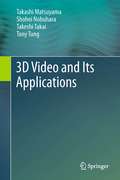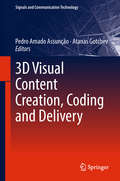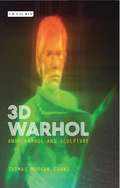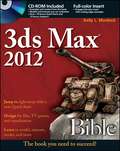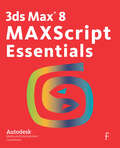- Table View
- List View
3D Printing with Fusion 360: Design for additive manufacturing, and level up your simulation and print preparation skills
by Sualp OzelImprove your Autodesk Fusion competence around 3D printing workflows by learning how to repair broken STLs, design for additive manufacturing, position and support parts, and slice themKey FeaturesUse Autodesk Fusion to import and repair external designs and create native lightweight designs for 3D printingMaster the setup of 3D printing within Fusion’s Manufacture workspaceGain insights into the different 3D printing technologies and the unique print preparation steps for their effective usePurchase of the print or Kindle book includes a free PDF eBookBook DescriptionAs 3D printing gains traction, the demand for CAD experts in manufacturing grows. If you're a fan of Autodesk Fusion and crave hands-on experience with automated modeling, generative design, and the full potential of additive manufacturing, this book is your guide to elevating your design and 3D printing skills. In this book, you’ll learn how to open CAD or Mesh files in Fusion and expertly repair, edit, and prepare them for 3D printing. You’ll unlock the secrets of effective print preparation, learning about print settings, support structures, and part orientation. This book also highlights Fusion’s diverse preferences designed specifically for additive manufacturing. Subsequent chapters will guide you in choosing the right part orientation and position, as well as creating suitable support structures based on your chosen printing technology. You’ll simulate the printing process to detect and remedy common print failures associated with the metal powder bed fusion process. Finally, you’ll leverage templates and scripts to automate routine tasks around print preparation. By the end of this 3D printing book, you'll be armed with the knowledge and skills necessary to harness the power of Fusion for additive manufacturing, meeting the growing demand with confidence.What you will learnUse Autodesk Fusion to open, inspect, repair, and edit externally created designs for 3D printingSet up your 3D prints for different printing technologies, such as FFF, SLA/DLP, SLS, and MPBFUse templates to automate your additive operations, including part orientation, arrangement, and supportRun process simulation for metal powder bed fusion and learn how to compensate for common print failure modesOptimize Fusion 360’s preferences for 3D printingExport machine-specific file formats for 3D printing, such as G-Code, SLI, SLC, and CLIWho this book is forIf you're a designer using Autodesk Fusion on a daily basis and want to delve into 3D printing or craft functional, lightweight prints, this book is your go-to. It's also a valuable reference for intermediate-level Fusion users seeking insights into DFAM (design for additive manufacturing) and print preparation. To get the most out of this book, it's recommended that you have a good understanding of Fusion's design features, familiarity with opening CAD or MESH files, and prior experience creating components in Fusion.
3D Research Challenges in Cultural Heritage: A Roadmap in Digital Heritage Preservation (Lecture Notes in Computer Science #8355)
by Marinos Ioannides Ewald QuakThis book contains selected contributions from some of the most renowned researchers in the field of Digital Heritage and 3D representation of the Past, based in large part on invited presentations from the workshop “Computational Geometry and Ontologies for Cultural Heritage 3D Digital Libraries: What are the future alternatives for Europeana?” which was held in conjunction with the International Conference on Cultural Heritage EuroMed2012 (www.euromed2012.eu) on the island of Cyprus in October 2012. This was the official event of the Cyprus Presidency of the Council of the European Union on Progress in Cultural Heritage Preservation. The aim of this book is to provide an insight to ongoing research and future directions in this novel, continuously very promising and multi-disciplinary evolving field, which lies at the intersection of digital heritage, engineering, computer science, mathematics, material science, architecture, civil engineering and archaeology.
3D Research Challenges in Cultural Heritage II: How to Manage Data and Knowledge Related to Interpretative Digital 3D Reconstructions of Cultural Heritage (Lecture Notes in Computer Science #10025)
by Sander Münster Mieke Pfarr-Harfst Piotr Kuroczyński Marinos IoannidesThis book reflects a current state of the art and future perspectives of Digital Heritage focusing on not interpretative reconstruction and including as well as bridging practical and theoretical perspectives, strategies and approaches. Comprehensive key challenges are related to knowledge transfer and management as well as data handling within a interpretative digital reconstruction of Cultural Heritage including aspects of digital object creation, sustainability, accessibility, documentation, presentation, preservation and more general scientific compatibility. The three parts of the book provide an overview of a scope of usage scenarios, a current state of infrastructures as digital libraries, information repositories for an interpretative reconstruction of Cultural Heritage; highlight strategies, practices and principles currently used to ensure compatibility, reusability and sustainability of data objects and related knowledge within a 3D reconstruction work process on a day to day work basis; and show innovative concepts for the exchange, publishing and management of 3D objects and for inherit knowledge about data, workflows and semantic structures.
3D Research Challenges in Cultural Heritage III: Complexity and Quality in Digitisation (Lecture Notes in Computer Science #13125)
by Marinos Ioannides Petros PatiasThis open access book presents a collection of papers focusing on current 3D research challenges in the domain of digital cultural heritage. 3D technologies find considerable use within the field of cultural heritage at the beginning of the 21st century, for example in the areas of data acquisition, modeling, archiving in local repositories, harvesting in digital libraries and their long-term preservation. This volume put emphasis on a number of challenges facing 3D research in the 2D/3D digitization of tangible objects and their transformation to digital/virtual/memory twins; the interplay of geometry, semantics and the recovery and management of knowledge in digital cultural heritage; the handling of 3D data via the Cloud on the Internet and mobile devices; the presentation of cultural heritage content in 3D to the general public; and the 3D reproduction of cultural heritage objects from virtual to real.
3D Rotations: Parameter Computation and Lie Algebra based Optimization
by Kenichi Kanatani3D rotation analysis is widely encountered in everyday problems thanks to the development of computers. Sensing 3D using cameras and sensors, analyzing and modeling 3D for computer vision and computer graphics, and controlling and simulating robot motion all require 3D rotation computation. This book focuses on the computational analysis of 3D rotation, rather than classical motion analysis. It regards noise as random variables and models their probability distributions. It also pursues statistically optimal computation for maximizing the expected accuracy, as is typical of nonlinear optimization. All concepts are illustrated using computer vision applications as examples. Mathematically, the set of all 3D rotations forms a group denoted by SO(3). Exploiting this group property, we obtain an optimal solution analytical or numerically, depending on the problem. Our numerical scheme, which we call the "Lie algebra method," is based on the Lie group structure of SO(3). This book also proposes computing projects for readers who want to code the theories presented in this book, describing necessary 3D simulation setting as well as providing real GPS 3D measurement data. To help readers not very familiar with abstract mathematics, a brief overview of quaternion algebra, matrix analysis, Lie groups, and Lie algebras is provided as Appendix at the end of the volume.
3D Rotations: Parameter Computation and Lie Algebra based Optimization
by Kenichi Kanatani3D rotation analysis is widely encountered in everyday problems thanks to the development of computers. Sensing 3D using cameras and sensors, analyzing and modeling 3D for computer vision and computer graphics, and controlling and simulating robot motion all require 3D rotation computation. This book focuses on the computational analysis of 3D rotation, rather than classical motion analysis. It regards noise as random variables and models their probability distributions. It also pursues statistically optimal computation for maximizing the expected accuracy, as is typical of nonlinear optimization. All concepts are illustrated using computer vision applications as examples. Mathematically, the set of all 3D rotations forms a group denoted by SO(3). Exploiting this group property, we obtain an optimal solution analytical or numerically, depending on the problem. Our numerical scheme, which we call the "Lie algebra method," is based on the Lie group structure of SO(3). This book also proposes computing projects for readers who want to code the theories presented in this book, describing necessary 3D simulation setting as well as providing real GPS 3D measurement data. To help readers not very familiar with abstract mathematics, a brief overview of quaternion algebra, matrix analysis, Lie groups, and Lie algebras is provided as Appendix at the end of the volume.
3D Structure from Images - SMILE 2000: Second European Workshop on 3D Structure from Multiple Images of Large-Scale Environments Dublin, Ireland, July 12, 2000, Revised Papers (Lecture Notes in Computer Science #2018)
by Marc Pollefeys Luc Van Gool Andrew Zisserman Andrew FitzgibbonThis volume contains the ?nal version of the papers originally presented at the second SMILE workshop 3D Structure from Multiple Images of Large-scale Environments, which was held on 1-2 July 2000 in conjunction with the Sixth European Conference in Computer Vision at Trinity College Dublin. The subject of the workshop was the visual acquisition of models of the 3D world from images and their application to virtual and augmented reality. Over the last few years tremendous progress has been made in this area. On the one hand important new insightshavebeenobtainedresultinginmore exibilityandnewrepresentations.Onthe other hand a number of techniques have come to maturity, yielding robust algorithms delivering good results on real image data. Moreover supporting technologies – such as digital cameras, computers, disk storage, and visualization devices – have made things possible that were infeasible just a few years ago. Opening the workshop was Paul Debevec s invited presentation on image-based modeling,rendering,andlighting.Hepresentedanumberoftechniquesforusingdigital images of real scenes to create 3D models, virtual camera moves, and realistic computer animations.Theremainderoftheworkshopwasdividedintothreesessions:Computation and Algorithms, Visual Scene Representations, and Extended Environments. After each session there was a panel discussion that included all speakers. These panel discussions were organized by Bill Triggs, Marc Pollefeys, and Tomas Pajdla respectively, who introduced the topics and moderated the discussion. Asubstantialpartoftheseproceedingsarethetranscriptsofthediscussionsfollowing each paper and the full panel sessions. These discussions were of very high quality and were an integral part of the workshop.
3D Structure from Multiple Images of Large-Scale Environments: European Workshop, SMILE'98, Freiburg, Germany, June 6-7, 1998, Proceedings (Lecture Notes in Computer Science #1506)
by Reinhard Koch Luc Van Gool3D Surface Reconstruction: Multi-Scale Hierarchical Approaches
by Francesco Bellocchio N. Alberto Borghese Stefano Ferrari Vincenzo Piuri3D Surface Reconstruction: Multi-Scale Hierarchical Approaches presents methods to model 3D objects in an incremental way so as to capture more finer details at each step. The configuration of the model parameters, the rationale and solutions are described and discussed in detail so the reader has a strong understanding of the methodology. Modeling starts from data captured by 3D digitizers and makes the process even more clear and engaging. Innovative approaches, based on two popular machine learning paradigms, namely Radial Basis Functions and the Support Vector Machines, are also introduced. These paradigms are innovatively extended to a multi-scale incremental structure, based on a hierarchical scheme. The resulting approaches allow readers to achieve high accuracy with limited computational complexity, and makes the approaches appropriate for online, real-time operation. Applications can be found in any domain in which regression is required. 3D Surface Reconstruction: Multi-Scale Hierarchical Approaches is designed as a secondary text book or reference for advanced-level students and researchers in computer science. This book also targets practitioners working in computer vision or machine learning related fields.
3D Synthetic Environment Reconstruction (The Springer International Series in Engineering and Computer Science #611)
by Mahdi AbdelguerfiAlthough synthetic environments were traditionally used in military settings for mission rehearsal and simulations, their use is rapidly spreading to a variety of applications in the commercial, research and industrial sectors, such as flight training for commercial aircraft, city planning, car safety research in real-time traffic simulations, and video games. 3D Synthetic Environment Reconstruction contains seven invited chapters from leading experts in the field, bringing together a coherent body of recent knowledge relating 3D geospatial data collection, design issues, and techniques used in synthetic environments design, implementation and interoperability. In particular, this book describes new techniques for the generation of Synthetic Environments with increased resolution and rich attribution, both essential for accurate modeling and simulation. This book also deals with interoperability of models and simulations, which is necessary for facilitating the reuse of modeling and simulation components.3D Synthetic Environment Reconstruction is an excellent reference for researchers and practitioners in the field.
3d Technology In Fine Art And Craft: Exploration Of 3d Printing, Scanning, Sculpting And Milling
by Bridgette MongeonThe possibilities for creation are endless with 3D printing, sculpting, scanning, and milling, and new opportunities are popping up faster than artists can keep up with them. 3D Technology in Fine Art and Craft takes the mystery out of these exciting new processes by demonstrating how to navigate their digital components and showing their real world applications. Artists will learn to incorporate these new technologies into their studio work and see their creations come to life in a physical form never before possible. Featuring a primer on 3D basics for beginners,interviews, tutorials, and artwork from over 80 artists, intellectual property rights information, and a comprehensive companion website, this book is your field guide to exploring the exhilarating new world of 3D. Follow step-by-step photos and tutorials outlining the techniques, methodologies, and finished products of master artists who have employed 3D technology in new and inventive ways Learn how to enlarge, reduce, and repurpose existing artwork and create virtual pieces in physical forms through a variety of mediums Research your options with an accessible list of pros and cons of the various software, 3D printers, scanners, milling machines, and vendors that provide services in 3D technology Listen to podcasts with the artists and learn more tips and tricks through the book's website at www.digitalsculpting.net
3d Technology In Fine Art And Craft: Exploration Of 3d Printing, Scanning, Sculpting And Milling
by Bridgette MongeonThe possibilities for creation are endless with 3D printing, sculpting, scanning, and milling, and new opportunities are popping up faster than artists can keep up with them. 3D Technology in Fine Art and Craft takes the mystery out of these exciting new processes by demonstrating how to navigate their digital components and showing their real world applications. Artists will learn to incorporate these new technologies into their studio work and see their creations come to life in a physical form never before possible. Featuring a primer on 3D basics for beginners,interviews, tutorials, and artwork from over 80 artists, intellectual property rights information, and a comprehensive companion website, this book is your field guide to exploring the exhilarating new world of 3D. Follow step-by-step photos and tutorials outlining the techniques, methodologies, and finished products of master artists who have employed 3D technology in new and inventive ways Learn how to enlarge, reduce, and repurpose existing artwork and create virtual pieces in physical forms through a variety of mediums Research your options with an accessible list of pros and cons of the various software, 3D printers, scanners, milling machines, and vendors that provide services in 3D technology Listen to podcasts with the artists and learn more tips and tricks through the book's website at www.digitalsculpting.net
3D Technology in Fine Art and Craft: Exploring 3D Printing, Scanning, Sculpting and Milling
by Bridgette MongeonThe possibilities for creation are endless with 3D printing, sculpting, scanning, and milling, and new opportunities are popping up faster than artists can keep up with them. 3D Technology in Fine Art and Craft takes the mystery out of these exciting new processes by demonstrating how to navigate their digital components and showing their real world applications. Artists will learn to incorporate these new technologies into their studio work and see their creations come to life in a physical form never before possible. Featuring a primer on 3D basics for beginners,interviews, tutorials, and artwork from over 80 artists, intellectual property rights information, and a comprehensive companion website, this book is your field guide to exploring the exhilarating new world of 3D. Follow step-by-step photos and tutorials outlining the techniques, methodologies, and finished products of master artists who have employed 3D technology in new and inventive ways Learn how to enlarge, reduce, and repurpose existing artwork and create virtual pieces in physical forms through a variety of mediums Research your options with an accessible list of pros and cons of the various software, 3D printers, scanners, milling machines, and vendors that provide services in 3D technology Listen to podcasts with the artists and learn more tips and tricks through the book's website at www.digitalsculpting.net
3D Technology in Fine Art and Craft: Exploring 3D Printing, Scanning, Sculpting and Milling
by Bridgette MongeonThe possibilities for creation are endless with 3D printing, sculpting, scanning, and milling, and new opportunities are popping up faster than artists can keep up with them. 3D Technology in Fine Art and Craft takes the mystery out of these exciting new processes by demonstrating how to navigate their digital components and showing their real world applications. Artists will learn to incorporate these new technologies into their studio work and see their creations come to life in a physical form never before possible. Featuring a primer on 3D basics for beginners,interviews, tutorials, and artwork from over 80 artists, intellectual property rights information, and a comprehensive companion website, this book is your field guide to exploring the exhilarating new world of 3D. Follow step-by-step photos and tutorials outlining the techniques, methodologies, and finished products of master artists who have employed 3D technology in new and inventive ways Learn how to enlarge, reduce, and repurpose existing artwork and create virtual pieces in physical forms through a variety of mediums Research your options with an accessible list of pros and cons of the various software, 3D printers, scanners, milling machines, and vendors that provide services in 3D technology Listen to podcasts with the artists and learn more tips and tricks through the book's website at www.digitalsculpting.net
3D Technology In Fine Art And Craft (PDF)
by Bridgette MongeonThe possibilities for creation are endless with 3D printing, sculpting, scanning, and milling, and new opportunities are popping up faster than artists can keep up with them. 3D Technology in Fine Art and Craft takes the mystery out of these exciting new processes by demonstrating how to navigate their digital components and showing their real world applications. Artists will learn to incorporate these new technologies into their studio work and see their creations come to life in a physical form never before possible. Featuring a primer on 3D basics for beginners,interviews, tutorials, and artwork from over 80 artists, intellectual property rights information, and a comprehensive companion website, this book is your field guide to exploring the exhilarating new world of 3D. Follow step-by-step photos and tutorials outlining the techniques, methodologies, and finished products of master artists who have employed 3D technology in new and inventive ways Learn how to enlarge, reduce, and repurpose existing artwork and create virtual pieces in physical forms through a variety of mediums Research your options with an accessible list of pros and cons of the various software, 3D printers, scanners, milling machines, and vendors that provide services in 3D technology Listen to podcasts with the artists and learn more tips and tricks through the book's website at www.digitalsculpting.net
3D TV and 3D Cinema: Tools and Processes for Creative Stereoscopy
by Bernard MendiburuThis book helps you master the technical requirements of shooting 3D stereoscopic images. This title defines the concept of a professional 3D camera system and describes what features are required to make a successful unit to keep your production on schedule and on budget.
3D TV and 3D Cinema: Tools and Processes for Creative Stereoscopy
by Bernard MendiburuThis book helps you master the technical requirements of shooting 3D stereoscopic images. This title defines the concept of a professional 3D camera system and describes what features are required to make a successful unit to keep your production on schedule and on budget.
3D-TV System with Depth-Image-Based Rendering: Architectures, Techniques and Challenges
by Ce Zhu, Yin Zhao, Lu Yu and Masayuki TanimotoRiding on the success of 3D cinema blockbusters and advances in stereoscopic display technology, 3D video applications have gathered momentum in recent years. 3D-TV System with Depth-Image-Based Rendering: Architectures, Techniques and Challenges surveys depth-image-based 3D-TV systems, which are expected to be put into applications in the near future. Depth-image-based rendering (DIBR) significantly enhances the 3D visual experience compared to stereoscopic systems currently in use. DIBR techniques make it possible to generate additional viewpoints using 3D warping techniques to adjust the perceived depth of stereoscopic videos and provide for auto-stereoscopic displays that do not require glasses for viewing the 3D image. The material includes a technical review and literature survey of components and complete systems, solutions for technical issues, and implementation of prototypes. The book is organized into four sections: System Overview, Content Generation, Data Compression and Transmission, and 3D Visualization and Quality Assessment. This book will benefit researchers, developers, engineers, and innovators, as well as advanced undergraduate and graduate students working in relevant areas.
The 3D Type Book
by FL@33This book is the most comprehensive showcase of three-dimensional letterforms ever written, featuring over 1,300 images of more than 300 projects by more than 160 emerging talents and established individuals and studios.Contributors include Sagmeister Inc, Vaughan Oliver, Milton Glaser, Alvin Lustig, Louis Danziger, Roger Excoffon, Paul Elliman, Marian Bantjes, Geoff Kaplan, Clotilde Olyff, Italo Lupi, Marion Bataille, Antoine+Manuel, Frost*Design, Mervyn Kurlansky, Non-Format, Oded Ezer, Rowland Scherman, Post Typography, Rinzen, Underware’s Type Workshop, J. Kyle Daevel, Ji Lee, Pleaseletmedesign, and Strange Attractors Design.As well as pioneering milestones from as far back as the 1940s, this book focuses on recent and brand new typographic projects. 3D type specialist Andrew Byrom explains the context and motivation behind these innovative works in an insightful foreword. Please visit the dedicated website 3d-type.com for additional info.
3D Video and Its Applications
by Takashi Matsuyama Shohei Nobuhara Takeshi Takai Tony TungThis book presents a broad review of state-of-the-art 3D video production technologies and applications. The text opens with a concise introduction to the field, before examining the design and calibration methods for multi-view camera systems, including practical implementation technologies. A range of algorithms are then described for producing 3D video from video data. A selection of 3D video applications are also demonstrated. Features: describes real-time synchronized multi-view video capture, and object tracking with a group of active cameras; discusses geometric and photometric camera calibration, and 3D video studio design with active cameras; examines 3D shape and motion reconstruction, texture mapping and image rendering, and lighting environment estimation; demonstrates attractive 3D visualization, visual contents analysis and editing, 3D body action analysis, and data compression; highlights the remaining challenges and the exciting avenues for future research in 3D video technology.
3D Visual Content Creation, Coding and Delivery (Signals and Communication Technology)
by Pedro Amado Assunção Atanas GotchevThis book covers the different aspects of modern 3D multimedia technologies by addressing several elements of 3D visual communications systems, using diverse content formats, such as stereo video, video-plus-depth and multiview, and coding schemes for delivery over networks. It also presents the latest advances and research results in regards to objective and subjective quality evaluation of 3D visual content, extending the human factors affecting the perception of quality to emotional states. The contributors describe technological developments in 3D visual communications, with particular emphasis on state-of-the-art advances in acquisition of 3D visual scenes and emerging 3D visual representation formats, such as: multi-view plus depth and light field;evolution to freeview and light-field representation;compression methods and robust delivery systems; andcoding and delivery over various channels. Simulation tools, testbeds and datasets that are useful for advanced research and experimental studies in the field of 3D multimedia delivery services and applications are covered. The international group of contributors also explore the research problems and challenges in the field of immersive visual communications, in order to identify research directions with substantial economic and social impact. 3D Visual Content Creation, Coding and Delivery provides valuable information to engineers and computer scientists developing novel products and services with emerging 3D multimedia technologies, by discussing the advantages and current limitations that need to be addressed in order to develop their products further. It will also be of interest to students and researchers in the field of multimedia services and applications, who are particularly interested in advances bringing significant potential impact on future technological developments.
3D Warhol: Andy Warhol and Sculpture (International Library of Modern and Contemporary Art)
by Thomas Morgan EvansRain machines; alarmed kosher pickle jars filled with gemstones; replica cornflakes boxes; 'disco décor'; time capsules; art bombs; birthday presents; perfume bottles and floating silver pillows that are clouds; paintings that are also films; museum interventions; collected and curated projects; expanded performance environments; holograms. This is a book about the vast array of sculptural work made by Andy Warhol between 1954 and 1987, a period that begins long before the first Pop paintings and ends in the year of his death.In 3D Warhol, Thomas Morgan Evans demonstrates that Warhol's engagement with sculpture and its traditional notions produced 'trespasses', bisecting across the expectations, allegiances and values within art historical, and ultimately, social, sites of investiture - or territories. This groundbreaking, original book brings to the forefront a major, but overlooked aspect of Warhol's oeuvre and provides an essential new perspective on the artist's legacy.
3ds Max 2012 (PDF)
by Kelly MurdockUpdated version of the bestselling 3ds Max book on the market 3ds Max 2012 Bible is one of the most popular 3ds Max how-tos on the market. If you're a beginner just itching to create something right away, the Quick Start project in Part 1 is for you. If you're an experienced user checking out 3ds Max 2012's latest and greatest features, you'll love the fact that the 3ds Max 2012 Bible continues to be the most comprehensive reference on this highly complex application. Find out what's new, what's tried and true, and how creative you can get using the tips, tricks, and techniques in this must-have guide. Don't miss the 16-page color insert with examples from cutting-edge 3D artists, as well as the DVD packed with all kinds of extras. Loaded with expert advice, timesaving tips, and more than 150 step-by-step tutorials Highlights the work of some of today's most cutting-edge 3D artists in a 16-page color insert Includes a companion DVD with all examples from the book, including unique models and texture that you can customize DVD also features 500 pages of extra content from previous editions of the 3ds Max Bible, including a set of Quick Start tutorials If you want to gain 3ds Max 2012 skills, whether you're just beginning or not, this is the book you need to succeed.
3ds Max 8 MAXScript Essentials
by AutodeskWrite your own MAXScript functions and utilities to create custom tools and UI elements, and automate repetitive tasks. Demonstrated techniques include the creation of objects, arrays, collections, control structures, parametric objects, and the construction of UI elements. The companion CD-ROM contains media files that allow you to practice the techniques with real-world examples demonstrating how you can use then in a production environment.
3ds Max 8 MAXScript Essentials
by AutodeskWrite your own MAXScript functions and utilities to create custom tools and UI elements, and automate repetitive tasks. Demonstrated techniques include the creation of objects, arrays, collections, control structures, parametric objects, and the construction of UI elements. The companion CD-ROM contains media files that allow you to practice the techniques with real-world examples demonstrating how you can use then in a production environment.

